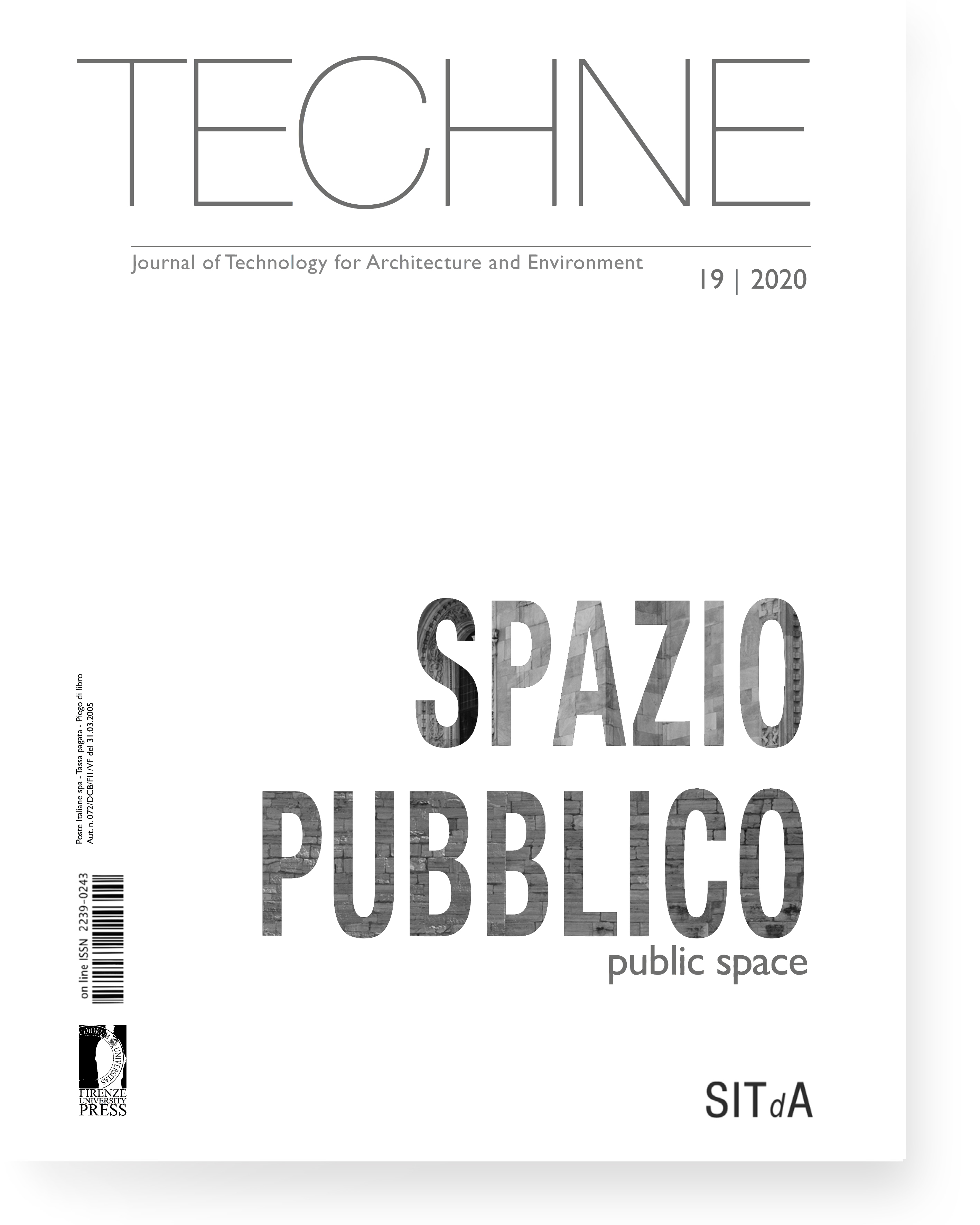Published 2020-01-21
How to Cite
Abstract
The public space. Design, construction, management. A meeting point, sometimes even conflicting, between interdisciplinary skills that extend its defining structures – in line with the evolutionary traces of the contemporary concept of public space – and the new ways of living, perceiving, managing and therefore thinking about it. The enhancement of urban space and the public sphere are at the center of attention of the contemporary debate as themes of interest to architects, philosophers, sociologists and anthropologists (to name a few: Habermas, Innerarity, Bauman, Augé, Gehl), as complex “places” to break down (Vadini, 20171). The term “public space” identifies several places, which show a broad and composite image of what is perceived as “everyone’s space”: not only squares, gardens and parks, but also buildings, often imagined as new squares, and paths, towards the hill or towards the countryside. Public space, therefore, understood as right is an innovative concept that can trigger forms of social protection from below and increase the quality of life and housing for families, young and old2.
The most obvious need is that of a new understanding of the common space, not only as something that can be governed and open to all, but as an essential aspect of our world that expresses, encourages and exemplifies new forms of social relations and shared experiences. An example of this are the neighborhood Laboratories, launched in 2017 in Bologna, thanks to the Urban Innovation Plan, which among the priorities highlighted the need to understand public spaces, such as places of proximity, where people and communities of different cultures, ages, passions can increase their social capital. Many European cities such as Bilbao, Marseille, Barcelona, Copenhagen have invested in public space in their urban regeneration strategies, recognizing the improvement of the quality of relationships as a determining factor for social rebalancing and the perception of happiness. In these cities, Bauman’s theory3 of emptying public space is particularly evident and bringing individuals and their relationships back to the scale of physical proximity is the challenge that the contemporary city must take to aspire to be truly smart (Briguglio, 20164).
Compared to the evolution of the debate in progress, the Reviews section proposes three texts selected according to a method that refers to three areas related to public space: the first strictly disciplinary, with reference to the Technology of Architecture, the second character more general but attributable to the Architecture Area, the third as an essay on the Theme. The connection between the concept of smartness together with that of healthiness is the common thread that introduces the disciplinary text – reviewe by Antonello Monsù Scolaro5 – “Smartness e healthiness per la transizione verso la resilienza. Orizzonti di ricerca interdisciplinare sulla città e il territorio” Franco Angeli, 2018 edited by Filippo Angelucci6.
The text, starting from the debate emerged during the international conference e-agorà. For the transition toward resilient communities (Torino, 2016) reconstructs a first framework between new theoretical positions, methodological experiments and applied research experiences, with respect to the paradigms of smartness and healthiness as the main vectors towards resilience.
Monsù Scolaro highlights the interdisciplinarity as a factor of social innovation with respect to these issues, noting how the points of connection between the two terms represent the new trajectories that describe the dynamic concepts between cities of the future and quality of life.
The loss of the principles around which the concept of urban quality is built is reproduced in the general text, kindred to the Architecture Area – reviewed by Roberto Giordano7 – “Urban Connections in the Contemporary Pedestrian Landscape” Routledge 2019, by Philip Pregill8.
The author describes the relationship between design strategies and enhancement of the urban context with the characterization of public spaces intended for user activities at different intervention scales, indicated in the text as: arterials, collectors, locals. Giordano addresses the issue with a critical examination that starts from the current scientific debate on the urban design and focuses on the conjugations of the expression connections as a junction mode between existing and changing places within the urban scene, through the different variations that Pregill gives in the various dedicated chapters. The third volume, as an essay on the Theme, concludes the investigation of the aspects that most characterize the relationships between urban space and the public sphere, with the text – reviewed by Andrea Tartaglia9 – “Colin Ward Architettura del dissenso. Forme e pratiche alternative dello spazio urbano”, Elèuthera, 2016, edited by Giacomo Borella10. He takes care of the interventions of C. Ward, recounting the reflections on the alternative practices of the urban space of one of the main observers of the hidden social history of urban planning and living in the second half of the twentieth century. Tartaglia highlights its salient features, focusing attention on the reasoning around the “fine grain” of the historic stratified city over time to which the modern contrasts “coarse grain fabric of the rebuilt and financially profitable city”. The need to regain possession of the city and to “do it yourself” underlined by Ward, becomes the background to bring real needs and targeted interventions closer together. An approach, therefore, in which the current problems of the contemporary city are recognized and reread between the real needs of users, changes in the quality of life levels and the role that public space can play in its design, social, cultural and sometimes unexpectedly ephemeral attitudes.






